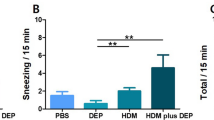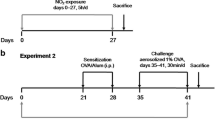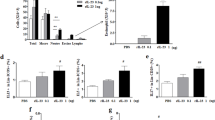Abstract
We have recently demonstrated that naphthoquinone (NQ), one of extractable chemical compounds of diesel exhaust particles (DEP), enhances antigen-related airway inflammation with goblet cell hyperplasia in mice (Inoue et al. in Eur Respir J 209(2):259–267, 2007). Further, NQ has enhanced lung expressions of interleukin (IL)-4 and IL-5. However, the effects of NQ on other cardinal features of asthma have not been completely investigated. The aim of the present study was to evaluate the effects of NQ on airway responsiveness on the model. Vehicle, NQ, ovalbumin (OVA), or NQ + OVA was administered intratarcheally to ICR mice for 6 weeks. Twenty-four hours after the last instillation, lung histology, lung functions such as total respiratory system resistance (R) and Newtonian resistance (R n), and protein level of IL-13 and mRNA level for MUC5AC in the lung were examined. Repetitive exposure to NQ aggravated antigen-related lung inflammation. NQ alone enhanced R and R n as compared to vehicle without statistical significance. OVA alone or NQ plus OVA showed increases in R and R n, which was prominent in NQ plus OVA (P < 0.05 vs. vehicle). Combined exposure to NQ and OVA elevated the levels of IL-13 and MUC5AC in the lung as compared with exposure to NQ or OVA alone. These results indicate that NQ can enhance airway hyperresponsiveness in the presence or absence of an antigen. Also, amplified lung expressions of IL-13 and MUC5AC might partly contribute to the deterioration of asthma features by NQ.

Similar content being viewed by others
References
Bolton JL, Trush MA, Penning TM, Dryhurst G, Monks TJ (2000) Role of quinones in toxicology. Chem Res Toxicol 13:135–160
Card JW, Carey MA, Bradbury JA, Graves JP, Lih FB, Moorman MP, Morgan DL, DeGraff LM, Zhao Y, Foley JF, Zeldin DC (2006) Cyclooxygenase-1 overexpression decreases Basal airway responsiveness but not allergic inflammation. J Immunol 177:4785–4793
Cho A, Di Stefano E, Ying Y, Rodriguez CE, Schmitz DA, Kumagai Y, Miguel AH, Eiguren-Fernandez A, Kobayashi T, Avol E, Froines JR (2004) Determination of four quinines in diesel exhaust particles, SRM 1649a, and atmospheric PM2.5. Aerosol Sci Technol 38:68–81
Cohn L, Elias JA, Chupp GL (2004) Asthma: mechanisms of disease persistence and progression. Annu Rev Immunol 22:789–815, 23:06
Davies DE, Wicks J, Powell RM, Puddicombe SM, Holgate ST (2003) Airway remodeling in asthma: new insights. J Allergy Clin Immunol 111:215–225
Delfino RJ (2002) Epidemiologic evidence for asthma and exposure to air toxics: linkages between occupational, indoor, and community air pollution research. Environ Health Perspect 110:573–589
Devouassoux G, Saxon A, Metcalfe DD, Prussin C, Colomb MG, Brambilla C, Diaz-Sanchez D (2002) Chemical constituents of diesel exhaust particles induce IL-4 production and histamine release by human basophils. J Allergy Clin Immunol 109:847–853
Gavett SH, Madison SL, Chulada PC, Scarborough PE, Qu W, Boyle JE, Tiano HF, Lee CA, Langenbach R, Roggli VL, Zeldin DC (1999) Allergic lung responses are increased in prostaglandin H synthase-deficient mice. J Clin Invest 104:721–732
Grunig G, Warnock M, Wakil AE, Venkayya R, Brombacher F, Rennick DM, Sheppard D, Mohrs M, Donaldson DD, Locksley RM, Corry DB (1998) Requirement for IL-13 independently of IL-4 in experimental asthma. Science 282:2261–2263
Heo Y, Saxon A, Hankinson O (2001) Effect of diesel exhaust particles and their components on the allergen-specific IgE and IgG1 response in mice. Toxicology 159:143–158
Hiyoshi K, Takano H, Inoue K, Ichinose T, Yanagisawa R, Tomura S, Cho AK, Froines JR, Kumagai Y (2005a) Effects of a single intratracheal administration of phenanthraquinone on murine lung. J Appl Toxicol 25:47–51
Hiyoshi K, Takano H, Inoue KI, Ichinose T, Yanagisawa R, Tomura S, Kumagai Y (2005b) Effects of phenanthraquinone on allergic airway inflammation in mice. Clin Exp Allergy 35:1243–1248
Ichinose T, Takano H, Miyabara Y, Sagai M (1998) Long-term exposure to diesel exhaust enhances antigen-induced eosinophilic inflammation and epithelial damage in the murine airway. Toxicol Sci 44:70–79
Inoue K, Takano H, Hiyoshi K, Ichinose T, Sadakane K, Yanagisawa R, Tomura S, Kumagai Y (2007) Naphthoquinone enhances antigen-related airway inflammation in mice. Eur Respir J 29(2):259–267
Kang HS, Blink SE, Chin RK, Lee Y, Kim O, Weinstock J, Waldschmidt T, Conrad D, Chen B, Solway J, Sperling AI, Fu YX (2003) Lymphotoxin is required for maintaining physiological levels of serum IgE that minimizes Th1-mediated airway inflammation. J Exp Med 198:1643–1652
Kasaian MT, Donaldson DD, Tchistiakova L, Marquette K, Tan XY, Ahmed A, Jacobson BA, Widom A, Cook TA, Xu X, Barry AB, Goldman SJ, Abraham WM (2006) Efficacy of IL-13 Neutralization in a Sheep Model of Experimental Asthma. Am J Respir Cell Mol Biol (in press)
Kikuno S, Taguchi K, Iwamoto N, Yamano S, Cho AK, Froines JR, Kumagai Y (2006) 1,2-Naphthoquinone activates vanilloid receptor 1 through increased protein tyrosine phosphorylation, leading to contraction of guinea pig trachea. Toxicol Appl Pharmacol 210:47–54
Kumagai Y, Taira J, Sagai M (1995) Apparent inhibition of superoxide dismutase activity in vitro by diesel exhaust particles. Free Radic Biol Med 18:365–371
Kuperman DA, Huang X, Koth LL, Chang GH, Dolganov GM, Zhu Z, Elias JA, Sheppard D, Erle DJ (2002) Direct effects of interleukin-13 on epithelial cells cause airway hyperreactivity and mucus overproduction in asthma. Nat Med 8:885–889
Lee JJ, Dimina D, Macias MP, Ochkur SI, McGarry MP, O’Neill KR, Protheroe C, Pero R, Nguyen T, Cormier SA, Lenkiewicz E, Colbert D, Rinaldi L, Ackerman SJ, Irvin CG, Lee NA (2004) Defining a link with asthma in mice congenitally deficient in eosinophils. Science 305:1773–1776
Monks TJ, Hanzlik RP, Cohen GM, Ross D, Graham DG (1992) Quinone chemistry and toxicity. Toxicol Appl Pharmacol 112:2–16
Morcillo EJ, Cortijo J (2006) Mucus and MUC in asthma. Curr Opin Pulm Med 12:1–6
Nakano T, Inoue H, Fukuyama S, Matsumoto K, Matsumura M, Tsuda M, Matsumoto T, Aizawa H, Nakanishi Y (2006) Niflumic acid suppresses interleukin-13-induced asthma phenotypes. Am J Respir Crit Care Med 173:1216–1221
Nikasinovic L, Momas I, Just J (2004) A review of experimental studies on diesel exhaust particles and nasal epithelium alterations. J Toxicol Environ Health B Crit Rev 7:81–104
O’Brien PJ (1991) Molecular mechanisms of quinone cytotoxicity. Chem Biol Interact 80:1–41
Rogers DF (2004) Airway mucus hypersecretion in asthma: an undervalued pathology? Curr Opin Pharmacol 4:241–250
Schuetzle D (1983) Sampling of vehicle emissions for chemical analysis and biological testing. Environ Health Perspect 47:65–80
Schuetzle D, Lee FS, Prater TJ (1981) The identification of polynuclear aromatic hydrocarbon (PAH) derivatives in mutagenic fractions of diesel particulate extracts. Int J Environ Anal Chem 9:93–144
Takano H, Ichinose T, Miyabara Y, Yoshikawa T, Sagai M (1998) Diesel exhaust particles enhance airway responsiveness following allergen exposure in mice. Immunopharmacol Immunotoxicol 20:329–336
Takano H, Yoshikawa T, Ichinose T, Miyabara Y, Imaoka K, Sagai M (1997) Diesel exhaust particles enhance antigen-induced airway inflammation and local cytokine expression in mice. Am J Respir Crit Care Med 156:36–42
Takizawa H (2004) Diesel exhaust particles and their effect on induced cytokine expression in human bronchial epithelial cells. Curr Opin Allergy Clin Immunol 4:355–359
Tliba O, Deshpande D, Chen H, Van Besien C, Kannan M, Panettieri RA Jr, Amrani Y (2003) IL-13 enhances agonist-evoked calcium signals and contractile responses in airway smooth muscle. Br J Pharmacol 140:1159–1162
Wills-Karp M (2004) Interleukin-13 in asthma pathogenesis. Immunol Rev 202:175–190
Wills-Karp M, Luyimbazi J, Xu X, Schofield B, Neben TY, Karp CL, Donaldson DD (1998) Interleukin-13: central mediator of allergic asthma. Science 282:2258–2261
Wynn TA (2003) IL-13 effector functions. Annu Rev Immunol 21:425–456
Yanagisawa R, Takano H, Inoue KI, Ichinose T, Sadakane K, Yoshino S, Yamaki K, Yoshikawa T, Hayakawa K (2006) Components of diesel exhaust particles differentially affect Th1/Th2 response in a murine model of allergic airway inflammation. Clin Exp Allergy 36:386–395
Zuhdi Alimam M, Piazza FM, Selby DM, Letwin N, Huang L, Rose MC (2000) Muc-5/5ac mucin messenger RNA and protein expression is a marker of goblet cell metaplasia in murine airways. Am J Respir Cell Mol Biol 22:253–260
Author information
Authors and Affiliations
Corresponding author
Rights and permissions
About this article
Cite this article
Inoue, Ki., Takano, H., Ichinose, T. et al. Effects of naphthoquinone on airway responsiveness in the presence or absence of antigen in mice. Arch Toxicol 81, 575–581 (2007). https://doi.org/10.1007/s00204-007-0186-5
Received:
Accepted:
Published:
Issue Date:
DOI: https://doi.org/10.1007/s00204-007-0186-5




